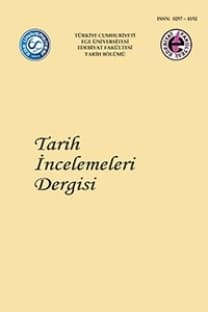Attila'nın Oğlu Dengizik'in Devleti İhya Mücadelesi,
The struggle of Dengizik, Son of Attila, to Revive the State
___
- Ahmetbeyoğlu 1995 Ali Ahmetbeyoğlu, Grek Seyyahı Priskos (V.asır)’a Göre Avrupa Hunları, İstanbul.
- Ahmetbeyoğlu 2001 Ali Ahmetbeyoğlu, Avrupa Hun İmparatorluğu, Ankara.
- Altheim 1952 F. Altheim, Attila et les Huns, Paris.
- Altheim 1956 F. Altheim and H. W. Haussig, Die Hunnen in Osteuropa, Baden.
- Altheim1959 F. Altheim, Geshichte Der Hunnen, I, Berlin.
- Appolinaris 1887 Sidonius Appolinaris, Epistulae et Carmina, bk. Monumenta Germaniae Historica, neşr. Leutjohann, VII, Berlin.
- Bóna 1991 I. Bóna, Das Hunnenreich, Stuttgart. Chronicon Poschale 1832 Chronicon Poschale, Corpus Scriptorum Historiae Byzantinae, neşr. G. Dindorf, Bonn.
- Czegledy 1969 K. Czegledy, Nomád népek vándorlása napkelettöl napnyugatig, Budapest.
- Diculescu 1922 C. Diculescu, Die Gepiden, I, Halle.
- Doerfer 1973 G. Doerfer, ‘‘Zur Sprache Der Hunnen’’, CAJ, 17, s.1-50.
- Donuk 1988 Abdülkadir Donuk, Eski Türk Devletlerinde İdarî-Askerî Ünvan ve Terimler, İstanbul.
- Fehér 1935 G. Fehér, ‘‘Attila’s Sohn: Irnik’’, Ungarische Jahrbücher, XV, s.408-432.
- Gibbon 1764 E. Gibbon, Roman Empire, I, Gordon 1960 C. D. Gordon, The Age of Attila, Michigan. Hambis 1971 L. Hambis, Attila et Les Huns, Paris.
- Harmatta 1951 J. Harmatta, ‘‘The Golden Bow of the Huns’’, Acta Archaeologica Academiae Scientiarum Hungaricae, I, s.107-149.
- Harmatta 1952 J. Harmatta, ‘‘A Hun Biradalom Felbomlása, I. A Hun társadalom Attila korában’’, A Magyar Tudomanyos Akadémia társadalm-történeti tudományok osztályánok közleményei II, 2, s.147-192.
- Jordanes 1882 Jordanes, Romana et Getica, Berolini.
- Macartney 1934 C. A. Macartney, ‘‘The End of the Huns’’, Byzantinisch- Neugriechische Jabrbücher, 10, Athen 1934, s.106-114.
- Maenchen-Helfen 1978 O. J. Maenchen-Helfen, Die Welt Der Hunnen, Köln. Marcellinus 1840 Marcellinus Comes, Chronicon, Chronica Minora, II, bk. Monumenta Germenia Historica, neşr. Th. Mommsen, Berlin.
- Marquart 1898 J. Marquart, Die Chronologie Der Alttürkischen Inschriften, Leipzig.
- Mátyás 1905 K. Mátyás, ‘‘Hol Van A Nedao Folyó’’, Századok, XXXIX, s.941-945.
- Mommsen1906 Th. Mommsen, Gesammelte Schriften, IV, Berlin.
- Moravcsik 1970 Gy. Moravcsik, Byzantium and the Magyars, Budapest.
- Némäti 1918 K. Némäti, Hun-történelmi Örökségünk, Budapest.
- Németh Gy. Németh, ‘‘A Hunok Nyelve’’, Attila és Hunjai, Budapest, 1940, s.217-226.
- Orkun 1933 H.N. Orkun, Attila ve Oğulları, İstanbul.
- Pigulevskaya 1969 N. Pigulevskaya, ‘‘Note Sur Les Relations De Byzance et Des Huns Au VI’s.’’, Revue Des Etudes Sud-Est Europeennes, VII, s.199-203.
- Pritsak 1982 O. Pritsak, ‘‘The Hunnic Language of the Attila Clan’’, Harvard Ukrainian Studies, VI, 4, s.428-476.
- Rásonyi 1938 L. Rásonyi, Macar Arkeolojisinde Hunlar, Avarlar, Macarlar, İstanbul.
- Rásonyi 1971 L. Rásonyı, Tarihte Türklük, Ankara. Reynolds and Lopez 1946 R.L.Reynolds and R. S. Lopez, ‘‘Odacer:German or Hun?’’ American Historical Review, 52, s.48-53.
- Schreiber 1978 H. Schreiber, Die Hunnen, München. Sinor 1977 D. Sinor, Inner Asia And Its Contacts With Medieval Europe, V. bölüm, Londra.
- Sinor 1990 D, Sinor, The Cambridge History of Early Inner Asia, Cambridge.
- Szász 1943 B.Szász, A Húnok Története, Attila Nagykiraly, Budapest.
- Thierry 1865 A. Thierry, Histoire D’Attila, Paris.
- Thompson 1948 E. A. Thompson, A History of Attila and the Huns, Oxford.
- Váczy P. Váczy, ‘‘A Hunok Európán’’, Attila és Hunjai (Szerkesztette, Gy. Németh), Budapest 1940, s.61-142.
- Vida1940 P. Vida, les Sicules Sont Hongrois, Budapest.
- ISSN: 0257-4152
- Yayın Aralığı: 2
- Başlangıç: 1983
- Yayıncı: Prof. Dr. Süleyman Özkan
Herodotos ve Yabancı Kültürler: Mısır Örneği
Hint Askerlerinin Singapur'daki İsyanı (1915)
Yeni Asur Metinlerinde Geçen Ay İsimleri
Dersaadet’te Bir Türk Dostu: Francis Hopkinson Smith (1838-1915
Chronica Maiora'da Moğol İmajı
Chronica Maiora'da Moğol İmajı,
Attila'nın Oğlu Dengizik'in Devleti İhya Mücadelesi
II. Meşrutiyet'ten Sonra Osmanlı'da Orta Öğretimler: Sultânîler
Uluslararası Altay Kazakları konf CONFERENCE:, Amp;quot;kazakhs Of The ALTAİ
